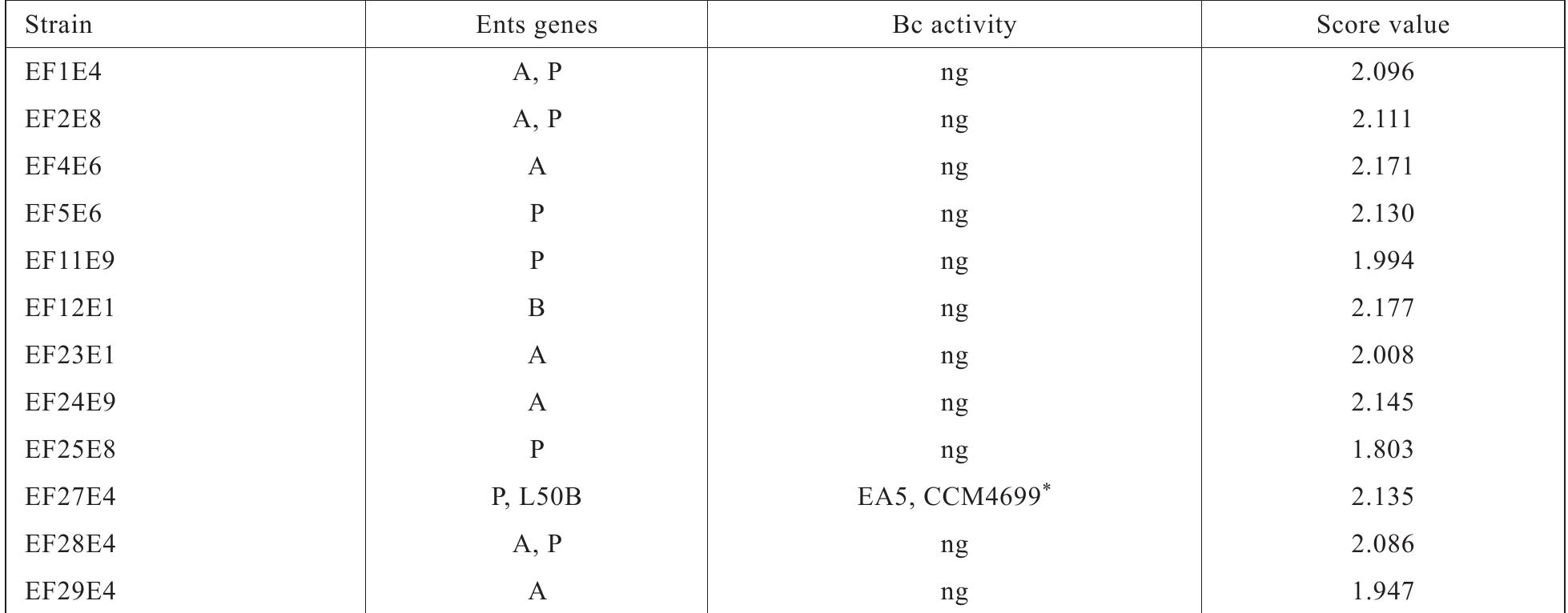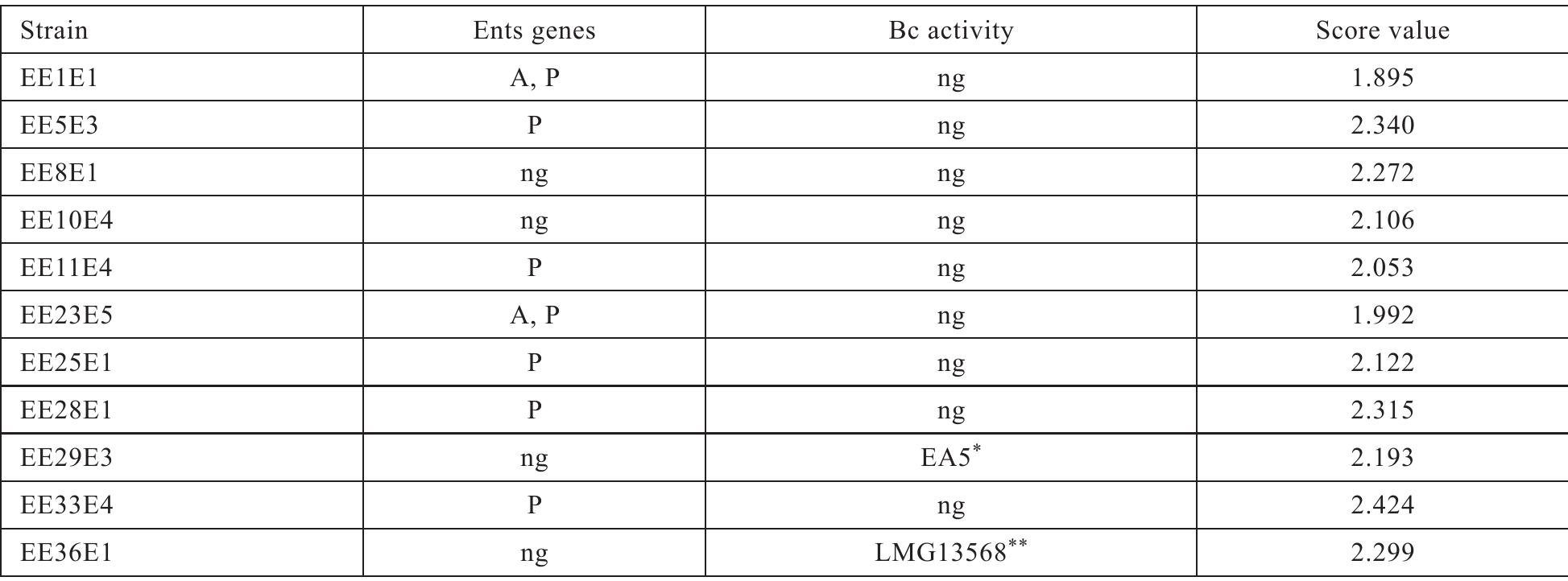Bioactive Enterococci Isolated from Slovak Ewes’ Lump Cheese (original) (raw)
Abstract
Enterococci are widespread organisms; some of their properties are desired in dairy industry. They can produce antimicrobial proteinaceous substances (enterocins) linked to food biopreservation. This study focused on bioactive
Figures (3)
Table 1. Sequences of the primer pairs (F — forward; R — reverse) used for PCR amplification of the structural genes of enterocins (Ent) A, P. B, and L50B
Table 2. Enterocins genes and bacteriocin activity of hemolysis and gelatinase negative Enterococcus faecium strains Ents = enterocins, Bc activity = bacteriocin-enterocin-like activity, ng = negative (no growth inhibition) Enterococcus faecium strains were hemolysis and gelatinase negative “Enterococcus avium EAS — our laboratory, Listeria monocytogenes CCM4699 — Czech Culture Collection, Brno, Czech Republic; inhibition zones in the range 10-20 mm
Table 3. Enterocins genes and bacteriocin activity of hemolysis and gelatinase negative Enterococcus faecalis strains Ents = enterocins, Bc activity = bacteriocin-enterocin activity, ng = negative or no inhibition “growth of EA5 was inhibited (zones size > 10 mm), “*Listeria innocua LMG 13568 (University of Ghent/Laboratory of Microbiology, Ghent, Belgium; inhibition zones 12 mm)

Loading Preview
Sorry, preview is currently unavailable. You can download the paper by clicking the button above.
References (37)
- Alatoom AA, Cunningham SA, Ihde S, Mandrekar J, Patel R (2011): Comparison of direct colony method versus extrac- tion method for identification of Gram-positive cocci by use of Bruker Biotyper matrix-assissted laser desorption ionization-time of flight mass spectrometry. Journal of Clinical Microbiology, 49, 2868-2873.
- Aymerich T, Holo H, Havarstein LS, Hugas M, Garriga M, and Nes IF (1996): Biochemical and genetic char- acterization of enterocin A from Enterococcus faecium, a new antilisterial bacteriocin in the pediocin family of bacteriocins. Applied and Environmental Microbiology, 62, 1676-1682.
- Baele M, Chiers K, Devriese LA, Smith HE, Wisselink HJ,Vaneechoutte M, Haesebrouck F (2001): The Gram- positive tonsillar and nasal flora of piglets before and after weaning. Journal of Applied Microbiology, 91, 997-1003. doi: 10.1046/j.1365-2672.2001.01463.x.
- Bhardwaj A, Malik RK, Chauhan P (2008): Functional and safety aspects of enterococci in dairy foods. Indian Journal of Mi- crobiology, 48, 317-325. doi: 10.1007/S12088-008-0041-2.
- Birollo GA, Reinheimer JA, Vinderola CG (2001): Entero- cocci vs. nonlactic acid microflora as hygiene indicators for sweetened yoghurt. Food Microbiology, 18, 597-604. doi: 10.1016/S0958-6946(99)00120-X.
- Casaus P, Nilsen T, Cintas LM, Nes LF, Hérnandéz PE, Holo H (1997): Enterocin B, a new bacteriocin from Enterococcus faecium T136 which can act synergistically with enterocin A. Microbiology, 143, 2287-2294. doi: 10.1099/00221287- 143-7-228-X.
- Cintas LM, Casaus P, Havarstain LS, Hérnandéz PE, Nes IF (1997): Biochemical and genetic characterization of enterocin P, a novel sec-dependent bacteriocin from Enterococcus faecium P1 with a broad antimicrobial spectrum. Applied and Environmental Microbiology, 43, 4231-4330. doi: 0099- 2240/97S04.00+0.
- Cintas LM, Casaus P, Holo H, Havarstain LS, Hérnandéz PE, Nes IF (1998): Enterocins L50A and L50B, two novel bac- teriocins from Enterococcus faecium L50 are related to staphylococcal haemolysins. Journal of Bacteriology, 180, 1988-1994.
- Franz CHMAP, Holzapfel WH, Stiles ME (1999): Enterococci at the crossroads of food safety? International Journal of Food Microbiology, 4, 1-24. doi: 10.1016/S0168-1605(99)00007-0.
- Franz CHMAP, van Belkum MJ, Holzapfel WH, Abriuel H, Gálvéz A (2007): Diversity of enterococcal bacteriocins and their grouping in a new classification scheme. FEMS Microbiology Review, 31, 293-310. doi: 10.1007/s12602- 009-9020.y.
- Giraffa G (1995): Enterococcal bacteriocins: their potential as anti-Listeria factors in dairy technology. Food Microbiol- ogy, 12, 291-299. doi: 10.1016/S0740-0020(95)80109-X.
- Giraffa G (2003): Functionality of enterococci in dairy products. International Journal of Food Microbiology, 88, 215-222. doi: 10.1016/S0168-1605(03)00183-1.
- Hill BM, Smythe B, Lindsay D, Shepherd J (2012): Microbiol- ogy of raw milk in New Zealand. International Journal of Food Microbiology, 157, 305-308. doi: 10.1016/j.ijfood- micro.2012.03.031.
- Kanemitsu K, Nishino T, Kunishima H, Okamura N, Takemura H, Yamamoto H, Kaku M (2001): Quantitative determina- tion of gelatinase activity among enterococci. Journal of Microbiological Methods, 47, 11-16. doi: 10.1016/S0167- 7012(01)00283-4.
- Kološta M, Slottová A, Drončovský M, Klapáčová L, Kmeť V, Bujňáková D, Lauková A, Greif G, Greifová M, Tomáška M (2014): Characterization of lactobacilli from ewes' and goats' milk for their further processing re-utilisation.
- Potravinárstvo® Scientific Journal of Food Industry, 8, 130-134. doi: 10.5219/434.
- Lauková A (1992): The effect of culture medium on bacteriocin production in some bacterial strains. Veterinary Medicine Czech, 37, 661-666.
- Lauková A, Czikková S (2001): Antagonostic effect of enterocin CCM4231 from Enterococcus faecium on "bryndza", a tradi- tional Slovak dairy product from sheep milk. Microbiologi- cal Research, 156, 31-34. doi: 10.1078/0944-5013-00078.
- Lauková A, Mareková M, Javorský P (1993): Detection and antimicrobial spectrum of a bacteriocin-like substances produced by Enterococcus faecium CCM 4231. Letters in Applied Microbiology, 16, 257-260. doi: 10.1111/j.1472- 765X.1993.tb01413.x.
- Lauková A, Chrastinová Ľ, Pogány Simonová M, Strompfová V, Plachá I, Čobanová K, Formelová Z, Chrenková M, Ondruška Ľ (2012): Enterococcus faecium AL41, its enterocin M and their beneficial use in rabbits husbandry. Peptides and Antimicrobial Proteins, 4, 243-249. doi: 10.1007/s12602- 012-9118-7.
- Lauková A, Kandričáková A, Ščerbová J (2015a): Use of bacteri- ocin-producing, probiotic strain Enterococcus faecium AL41 to control intestinal microbiota in farm ostriches. Letters in Applied Microbiology, 60, 531-535. doi: 10.1111/lam.12409.
- Lauková A, Strompfová V, Plachá I, Čobanová K, Faix Š, Pogány Simonová M (2015b): Beneficial effect of enterocin M-producing, probiotic strain Enterococcus faecium AL41 in model experiment with hens. Global Journal of Animal Scientific Research, 3, 206-213.
- Mareková M, Lauková A, De Vuyst L, Skaugen M, Nes IF (2003): Partial characterization of bacteriocins produced by environmental strain Enterococcus faecium EK13. Journal of Applied Microbiology, 94, 523-530. doi: 10.1007/S12602.
- Piskoríková M (2010): Quality and characterization of exist- ing and new probiotics (EFSA QPS). In: Proc. Regulatory Framework Workshop Health Claim Approval of Probiotics in the European Union. Issues, Barriers, Success Drivers. Košice, Slovak Republic. p.18.
- Pogány Simonová M, Lauková A, Žitňan R, Chrastinová Ľ (2015): Effect of rabbit-origin enterocin-producing probiotic strain Enterococcus faecium CCM7420 appli- cation on growth performance and gut morphometry in rabbits. Czech Journal of Animal Science, 60, 509-512. doi: 10.17221/8559-CJAS.
- Qin X, Singh KV, Weinstock GM (2001): Characterization of fsr, a regulator controlling expression of gelatinase and serine protease in Enterococcus faecalis OG1RF. Journal of Bacteriology, 183, 3372-3382. doi: 10.1021/ jf5006269. Regulation (EC) No. 1924/2006 of the European Parliament and of the Council of 20 December 2006 on nutrition and health claims made on food. Official Journal of the European Union, 49, L404, 9-25.
- Ribeiro T, Oliviera M, Fraqueza MJ, Lauková A, Elias M, Tenreiro R, Barreto AS, Semedo-Lemsaddek T (2011): An- tibiotic resistance and virulence factors among enterococci isolated from Chourico, a traditional Portuguese dry fer- mented sausage. Journal of Food Protection, 74, 465-469. doi: 10.4315/0362-028X.
- Semedo T, Santos MA, Lopes MFS, Figueiredo Marques JJ, Barreto Crespo MT, Tenreiro R (2003): Virulence factors in food, clinical and reference enterococci: a common trait in the genus? Systematic and Applied Microbiology, 26, 13-22. doi: 10.1016/S0378-1127(98)00404-6.
- Semedo-Lemsaddek T, Nóbrega CS, Ribeiro T, Pedroso NM, Sales-Luís T, Rosalino M, Lemsaddek A, Tenreiro R, Tavares L, Vilela CL, Oliveira M (2013): Virulence traits and anti- biotic resistance among enterococci isolated from European otter (Lutra lutra). Veterinary Microbiology, 16, 378-382. doi: 10.1016/j.vetmic.2012.12.032.
- Singh KV, Qin X, Weinstock GM, Murray BE (1998): Genera- tion and testing of mutants of Enterococcus faecalis in a mouse peritonitis model. Journal of Infectious Diseases, 178, 1416-1420. doi: 10.1128/IAI.00149-09.
- Skalka B, Pillich J, Pospíšil L (1983): Further observation on Corynebacterium renale as an indicator organism in the detection of exfoliation-positive strains of Staphylococcus aureus. Zentralblatt für Bakteriologie, Mikrobiologie und Hygiene, A256, 168-174.
- Strompfová V, Lauková A, Simonová M, Marciňáková M (2008): Occurrence of the structural enterocin A, P, B, L50B genes in enterococci of different origin. Veterinary Microbiology, 132, 293-301. doi: 10.1016/j.vetmic.2008.05.001.
- Szabóová R, Lauková A, Pogány Simonová M, Strompfová V, Chrastinová Ľ (2012): Bacteriocin-producing entero- cocci from rabbit meat. Malaysian Journal of Microbiology, 211-218.
- Vrabec M, Lovayová V, Dudríková K, Gallo J, Dudríková E (2015): Antibiotic resitsance and prevalence of Enterococ- cus spp. and Escherichia coli isolated from bryndza cheese. Italian Journal of Animal Science, 14, 609-614. doi: 10.481/ ijas.2015.4076.
- Waters CM, Antiporta MH, Murray BE, Dunny GM (2003): Role of the E. faecalis gelE protease in determination of cellular chain length, supernatant pheromone levels and degradation of fibrin and misfolded surface proteins. Journal of Bacteriology, 185, 3613-3623.
- Woodford N, Egelton MC, Morrison D (1997): Comparison of PCR with phenotypic methods for the speciation of entero- cocci. Advance and Experimental Medicine, 418, 405-408.
- Corresponding Author: MVDr. Andrea L a u k o v á , CSc., Slovak Academy of Sciences, Institute of Animal Physiology, Šoltésovej 4-6, 040 01 Košice, Slovak Republic, phone: + 421 557 922 964, e-mail: laukova@saske.sk


